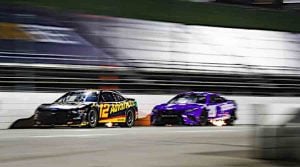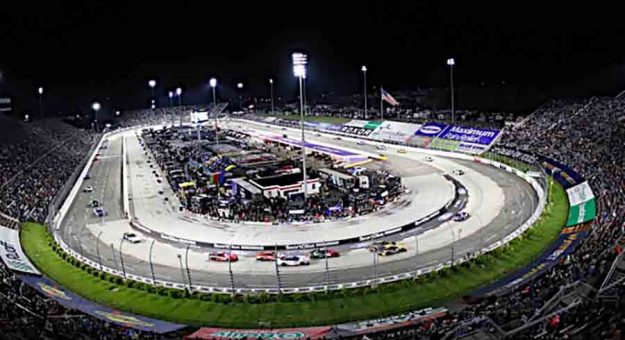To answer the question prompted in the headline of this article: Not a heck of a whole lot.
Saturday night’s NASCAR Cup Series race at Martinsville Speedway was simply: baffling uneventful.
No one expected Martinsville – which in the last few years occupied the same space in the collective imagination that Bristol Motor Speedway did from 1995 to 2004 – to put on the absolute worst race of the 2022 NASCAR Cup season through eight weekends.
But it did.
William Byron won the (thankfully) 403-lap race after having led 212 circuits of the half-mile track. During the two hours and 40 minutes it took to run the night race there were:
- No on-track green flag passes for the lead.
- Only two “natural” cautions outside the stage breaks. That was the fewest “natural” cautions in a Cup race at Martinsville since 1971 – a year before the start of the Modern Era.
- Chase Elliott and Byron combined to lead all but six laps.
So why did this happen? Why was the first Next Gen points race on a track shorter than Richmond a total bust?
Saturday’s race was at the shortest track the Next Gen car has competed on since the Clash at the L.A. Coliseum. Last week’s race took place at 3/4-mile Richmond Raceway, a short track where aero comes into play. To the apparent surprise of many, the Next Gen car required shifting at multiple points around Martinsville..
Did that impact the ability to get near cars and pass?

Not according to Rudy Fugle, crew chief on Byron’s No. 24 Chevy, who pointed to the weather.
Saturday’s race was delayed by about about 45 minutes thanks to rain – even sleet! – and the coldest temperatures of the season. The weekend had already seen rain delay the Xfinity Series race Saturday night.
“I think it was the weather really,” Fugle said. “If it was 55, 65 (degrees), (the tires) would have laid some rubber down, you would have seen some different things, and definitely would have had some more falloff, and you would have seen the normal clumping and moving up a little bit in the center and just seeing a little maneuverability, but with the rain and it being so cold, just couldn’t help it; that’s just the kind of race it was, I think.”
Austin Dillon, who placed third after running in second for large portion of the last stage, seemed to agree.
“When it gets hot and slick it’s gonna be a different race,” Dillon said. “I mean some people probably want a different tire but it’s gonna change drastically with the weather. It’s got to be the coldest Martinsville race we’ve had … I just think it’s a night race at (Martinsville) what is (the temperature)? … 38 degrees? I mean, I’m freezing. I never get out of a race car (wearing) two jackets and a toboggan. You can have great racing at places that have tire fall off. Martinsville has tire fall off, but it’s usually when rubber is able to lay down and it’s hot outside.”
Saying the racing will be better next time seems somewhat optimistic. The fall Martinsville race is the final cutoff race in the playoffs. This year’s race is scheduled for Oct. 30. There’s no guarantee it will be significantly warmer than Saturday night.
Ryan Blaney, who finished fourth, doesn’t think the weather was a deciding factor.
“If it was 90 degrees, you still would have been plowing tight behind somebody,” Blaney said. “The exits would have been worse. The entry and exit would have been more slick, but that would have been for everybody. When you’re in dirty air, you’re in dirty air. You can’t even get in the corner and roll to a guy to put the bumper to him. You just can’t get there, so I don’t know if the hotter temperatures would have helped. You still would have been tight behind someone who is slowing your center down too much to where you couldn’t get a run on them, so it probably wouldn’t have hurt it being a little hotter, but I wouldn’t blame cold temps on that.”
So is it the car?
Ross Chastain, who finished fifth for his series-leading fifth top five, warned people they may be remembering the Gen 6 car “a lot better” than it was.
“It was always hard to pass at Martinsville,” Chastain said. “So that’s why people love this place. We have to move people out of the way. And I only have two races in the past on a funded team. It was hard to pass last year. It was impossible, basically. I think everybody’s remembering it as better than it was. I think it would’ve been the same way with a Gen 6, 5, 4, 3, 2 and 1.”
Would a change in horsepower help in a return visit to NASCAR’s oldest track? Saturday’s race was held with a 670 HP package after last year’s short-track package was with 750 HP.
Blaney believes so.
“It definitely wouldn’t have hurt it,” Blaney said. “You could spin tires pretty good late in runs – like with 80 laps on your stuff you could spin tires – but if you were just in dirty air behind the guy on exit, you were spinning tires just as bad even though if you thought you had better drive than him. It all starts in the middle of the corner of being able to roll to guys and then pick up the gas kind of with them, so that’s the thing you need, but more horsepower wouldn’t have hurt.
“There was a lot of shifting tonight. I didn’t run one lap without shifting, so that was a lot of shifts. More horsepower definitely wouldn’t hurt, but I don’t think it’s the whole issue.”
